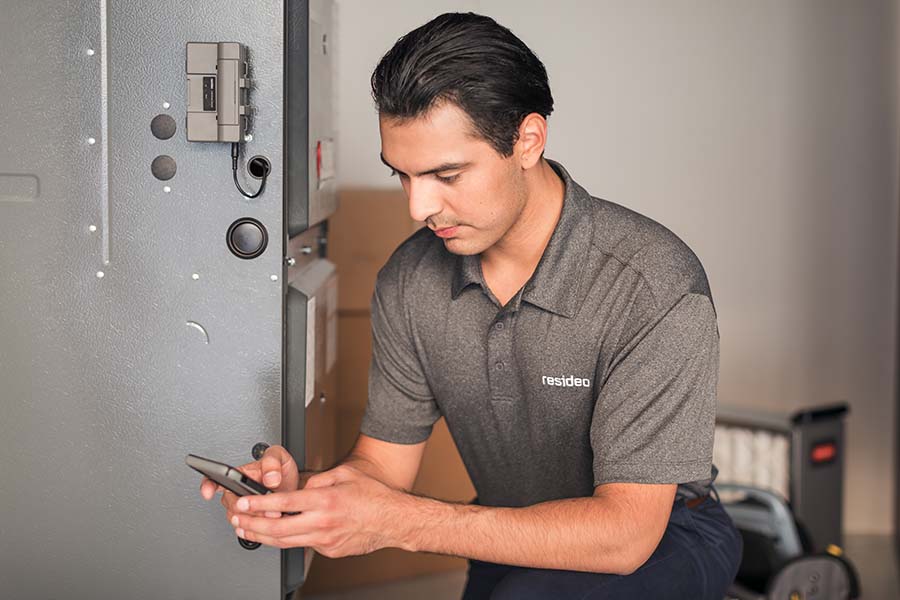When it comes to the Internet of Things (IoT), contractors may be a little apprehensive about differentiating between manufacturer solutions, as well as learning how to fully utilize the technology. The good news is at its core, an IoT solution has a common architecture, said Carri Norton, director of digital product development, residential HVAC and supply at Trane Technologies. For example, there must be sensors to collect data and some functionality for sending this data to make it available for an application to use. There will also be an application available that may differ depending on the type of customer.
“The main differences between varying manufacturers’ solutions will be the specific features offered in the application and technically, how the different components of this architecture are implemented,” she said. “Contractors looking at these offerings can look for things like applications available (e.g., customer facing app, technician app, web portals) and available features, equipment supported, data available, app reviews, etc.”
Gundeep Singh, executive director of digital and analytics at Carrier, added that on a technical level, IoT technology rigor can be evaluated by thinking through a breadth of sensing capabilities, refresh rate and bandwidth, range of communication, compatibility of communication protocols, and depth of edge compute capabilities. However, he recommends comparing what different manufacturers can do with the data once they have it.
“The technology is nothing without the customer and the benefits that we can give them,” he said. “We also cannot underestimate the requirements to extract meaningful use cases from IoT data (it requires everything from attracting data science talent to working with the right ecosystem partners). Therefore, rather than getting caught up in technical specs and details that change every few months, contractors should instead focus on what features they value most and how easily they can access these features.”
Learning Curve
When it comes to learning how to use IoT-enabled equipment, it is really a fairly simple process, because by design, IoT takes most of the learning out of the equation, said Rick Warner, president of Ecoer North America.
“If the installers can operate an app, they can operate the IoT device,” he said. “The only difference might be the app design, as those that are less intuitive might be a challenge.”
Overall, though, the learning curve should be relatively short, as contractors are already used to looking at a number of data points, which are usually collected by placing physical gauges on the system at the time of service or repair. The difference with IoT is that information can be made available to contractors before the service call, said Singh, as OEMs are using best-in-class data science and AI capabilities in order to deliver prescriptive insights into systems that might not be performing at the right levels.
“While most of these capabilities are intuitive enough, some hand holding might be needed upfront, and there are training capabilities available for contractors to become more digital,” he said. “The right investments in user experience significantly reduce the need for traditional training. IoT technology is all about being seamless and touchless.”
What’s Available
There are a variety of IoT solutions available from manufacturers. Resideo, for example, offers Pro-IQ LifeWhere, which is a complete platform that contractors can use to monitor and diagnose issues in the home. The platform includes sensors that connect to equipment, while sensor hubs aggregate the data at the equipment and transmit it to a gateway for further aggregation and transmission to the LifeWhere cloud platform. From there, the data is stored and processed.

COMPLETE PLATFORM: Resideo offers Pro-IQ LifeWhere, which is a complete platform that contractors can use to monitor and diagnose issues in the home. (Courtesy of Resideo)
“Predictive analytics and machine learning is applied to the data and equipment runs are classified as good or bad,” said Brian Courtney, vice president and general manager of home analytics at Resideo. “From there, bad runs generate alerts that show up in a web portal. Contractors are then able to review and analyze the data and create opportunities for repair. The data flows both to the homeowner as alerts via a mobile application to scheduling systems so that the contractor and homeowner can schedule the repair. All hardware and software can be white labeled by the contractor (branded with their company name) to provide a seamless solution to the homeowner.”
Ecoer’s entire product line is based on the technology advantages delivered through the IoT gateway system, so a multitude of sensors are built into the equipment at the factory. These sensors measure items such as temperature, pressure, and current, and the data from the sensors is fed to the specifically-designed master control board. The control board then sends the data to the cellular-based gateway, which then sends it to the cloud.
“The cloud is accessed by the installing contractor and the Ecoer tech support site via an app,” said Warner. “The installing contractor (or any contractor associated with the unit) can view the system 24/7 via the app, and they can also look back for 60 days at the performance. The Ecoer tech support team can look back from the moment it was started. We have also taken out the manual product registration process by including it in the automation. At Ecoer, we feel IoT technology is the future of HVAC. Everything we do revolves around the IoT advantages, and all our research and development is based on how we can enhance the IoT experience.”

SMART THERMOSTATS: Trane’s Smart Thermostats enable the customer to use the Trane Home application, which enables the use of Trane Diagnostics for the dealer. (Courtesy of Trane Technologies)
Trane’s complete system solution provides dealers with the data and control they need to manage resources more efficiently. The company’s smart thermostats enable the customer to use the Trane Home application, which enables the use of Trane Diagnostics for the dealer. Dealers can benefit from this solution even without Trane equipment; however, Trane communicating equipment provides even more data and analytics when used with Diagnostics, said Norton.
“Trane also just introduced Trane Link, which is a next-generation communicating platform that wirelessly communicates with the Trane Diagnostics mobile app, helping to ensure installation accuracy and faster commissioning during the installation process of variable-speed systems,” said Norton. “Plus, the Trane Diagnostics mobile app accesses Trane Link’s built-in system sensors for simple configuration and diagnosing.”
Carrier offers a wide array of products that provide homeowners with smart air purifiers, communicating controls, and connected HVAC equipment, with Carrier Infinity HVAC being one of the most sophisticated and connected equipment offerings in the industry today, said Singh.
“The IoT diagnostics are shared via our smart Carrier Home app, allowing consumers to monitor energy consumption, system operating status, comfort metrics and more,” he said. “For our channel, we package our IoT data in our mobile apps and web platforms available on Carrier’s HVAC partners. Our channel partners can thoroughly investigate and troubleshoot Infinity equipment remotely before they roll out a truck to physically repair these units. We continue to invest in our capabilities, and our channel can expect industry-leading diagnostic experiences in the coming months.”
The demand for IoT-enabled HVAC equipment is growing rapidly, and, “as prices decrease, availability grows, and use cases become more relevant for consumers, homeowners will expect that even entry-level equipment will provide some level of convenience that connectivity provides,” said Singh. “I am so excited to see how this world evolves.”






Report Abusive Comment